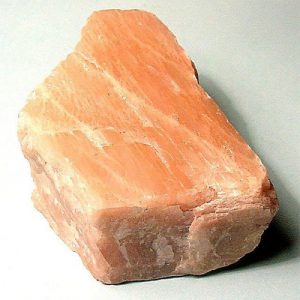Orthoclase (Feldspar)
Orthoclase is a member of the Potassium Feldspars of the Feldspar Group of minerals that also includes Albite, Amazonite, Andesine, Anorthite, Bytownite, Hyalophane, Labradorite, Moonstone, Oligoclase, Orthoclase, Sanidine and Sunstone. Orthoclase was named for those in 1801 by Rene Just Haüy from the Greek word orthos meaning right in allusion to the cleavage angle. The name was changed to orthoclase in 1823 by Johann Friedrich August Breithaupt. He added klase from the Greek word kalo meaning I cleave because its cleavages are at right angles. The sense of Haüy’s naming of Orthoclase was that the mineral was a Feldspar, but he did not specify a type locality or a chemical analysis.
Orthoclase is a component of many rocks, especially alkalic and plutonic acid rocks, also granites, pegmatites and syenites. Feldspars are the most common minerals on the Earth’s surface. Gem quality Orthoclase crystals are found at several locations around the world but Madagascar produces the largest cuttable Orthoclase known. Crystals from Itrongahy, Madagascar are very fine, transparent yellow and very large, up to 250 carats. Yellow and colorless Catseye gems are known from the gem gravels of Burma (Myanmar) and Sri Lanka.
Orthoclase distribution: Widespread. Fine examples from St. Gotthard, Ticino, and at Val Giuv, Tavetsch, Graubünden, Switzerland. In the Zillertal, Tirol, Austria. From Baveno, Piedmont, in the Pfitschtal, Trentino-Alto Adige, and at San Piero in Campo, Elba, Italy. At Epprechtstein, Bavaria, Carlsbad, Bohemia, and Manebach, Thuringia, Germany. From Cornwall, England. In Russia, from the Mursinka-Alabashka area, near Yekaterinburg (Sverdlovsk), Ural Mountains. In the USA, from Maine, at Paris and Buckfield, Oxford County; at Cornog, Chester County, and Blue Hill and Lieperville, Delaware County, Pennsylvania. In California, from the Pala and Mesa Grande districts, San Diego County; in Colorado, on Mt. Antero, Chaffee County; at Crystal Pass, Goodsprings, Clark County, Nevada. From Guanajuato, Mexico. At Tanokamiyama, Shiga Prefecture, Japan. Gem crystals from Ampandrandava, Fianarantsoa, and Itrongay, near Betroka, Madagascar.
| Category: | Silicate mineral |
| Chemical Formula: | KAlSi3O8 |
| Potassium Aluminum Silicate | |
| Molecular Weight: | 278.33 gm |
| Composition: | Potassium | 14.05 % | K | 16.92 % | K2O |
| Aluminum | 9.69 % | Al | 18.32 % | Al2O3 | |
| Silicon | 30.27 % | Si | 64.76 % | SiO2 | |
| Oxygen | 45.99 % | O | |||
| 100.00 % | 100.00 % | = TOTAL OXIDE |
| Crystallography: | Monoclinic – Prismatic |
| Crystal Habit: | Crystals commonly short prismatic along [100] or [001], tabular on [010], to 20 cm. Cleavable, granular, massive. |
| Twinning: | Common as simple, contact, or penetration twins according to the Carlsbad, Baveno, or Manebach laws. |
| Cleavage: | Perfect on {001} and {010}; partings on {100}, {110} and {201} |
| Fracture: | Conchoidal to irregular/uneven |
| Tenacity: | Brittle |
| Moh’s Hardness: | 6.0 |
| Density: | 2.55 – 2.63 (g/cm3) |
| Luminescence: | None |
| Radioactivity: | Barely Detectable; GRapi = 200.97 (Gamma Ray American Petroleum Institute Units) |
| Color: | Colorless, white, gray, pale yellow, flesh-red, green; colorless in thin section; may exhibit opalescence or schiller iridescence |
| Transparency: | Transparent to translucent |
| Luster: | Vitreous, pearly on cleavages |
| Refractive Index: | 1.518 – 1.525 Biaxial ( – ) |
| Birefringence: | 0.004 – 0.005 |
| Dispersion: | Distinct, r > v |
| Pleochroism: | None |


